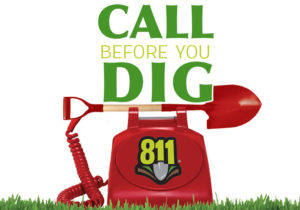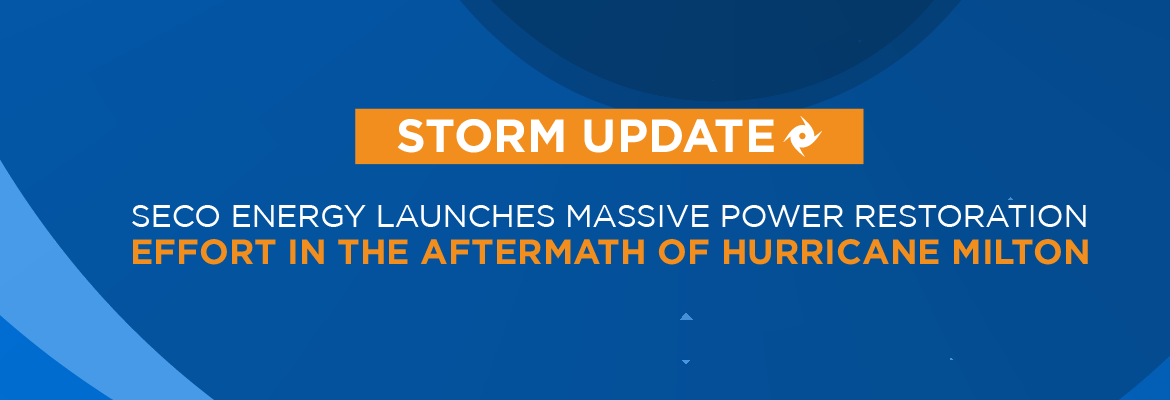SECO Energy Launches Massive Power Restoration Effort in the Aftermath of Hurricane Milton
Hurricane Milton made landfall near Siesta Key on Wednesday night as a Category 3 hurricane, leaving thousands of homes and businesses without power. In response, SECO Energy began a massive restoration effort to rebuild electric infrastructure, which sustained significant damage from Hurricane Milton, widespread across SECO’s service area. Hundreds of workers from multiple states are assisting, and additional crews are being called to accelerate the recovery.
Over 100,000 accounts have experienced service disruption from Hurricane Milton, including six substations that lost the transmission feed from another utility. SECO crews and mutual aid line and tree crews worked to restore electric service until 7 p.m. last night when strong winds halted restoration for 13 hours. Restoration efforts resumed early this morning, and crews will work around the clock until every SECO Energy member’s power is fully restored. Additional crews are being called in to assist.
As of 9 a.m. Thursday morning, just under 90,000 locations remain without electricity due to fallen trees, downed lines, broken poles, and severe flooding. SECO Energy will work quickly and safely to bring members back online. Complete power restoration is expected to take multiple days.
“As we work to restore power in the aftermath of Hurricane Milton, we have assembled a force of SECO home team crews and hundreds of line and tree crews from across the nation to support what will be one of the largest power restoration efforts in SECO’s history,” said Curtis Wynn, Chief Executive Officer of SECO Energy. “I want to assure our members that SECO Energy is committed to getting the lights back on as quickly and safely as possible and will not stop until service has been restored to every member.”
SECO Energy prioritizes restoring service to shelters, hospitals, schools, and emergency services (i.e., emergency ops centers, fire stations, and law enforcement facilities) to minimize the impact on public safety and health services. Next, crews restore electric service to the largest number of people in the shortest time possible until every member’s power is restored.
Members who require electric service for life-sustaining medical equipment should have a backup power source or plan to relocate. If using a portable generator, follow the manufacturer’s instructions carefully. Always operate generators outside on dry surfaces, away from rain, directing the generator’s exhaust away from your home and any nearby air intakes to other buildings. Deadly levels of carbon monoxide can build up fast from a portable generator’s exhaust.
For outage reporting and updates, SECO Energy offers StormCenter, an outage and communications platform. Members can report outages, check the status of an outage, and sign up for alerts via email, text, or phone. Visit SECOEnergy.com > StormCenter and bookmark the page for quick access.
SECO Energy remains dedicated to restoring power and ensuring the safety of its members during this critical time.
Members are reminded to stay safe and encouraged to adhere to the following safety tips, as conditions remain hazardous in many areas:
• Stay away from downed wires. Always assume they are energized. Call 911 if you see a downed line.
• Avoid flooded areas. Flooding is a major threat from Hurricane Milton. Flash flooding can occur suddenly due to intense rainfall. Long-term flooding along rivers and streams can persist for days following a storm. When approaching water on a roadway, remember: Don’t Drown. Turn Around.
• Avoid crews working in the street. This will keep you and the crews safe and allow them to work on restoring your power.
• If you plan to use a portable generator, follow the manufacturer’s instructions and use only when necessary. Don’t overload it. Be sure to turn it off at night when you’re asleep or if you leave your home.
• To avoid the risk of carbon monoxide poisoning, place portable generators outside in a well-ventilated area, more than 20 feet away from your home, doors, and windows. Never run a generator inside, not even in your garage. Do not connect the generator directly to your home’s main fuse box or circuit panel.
• Protect food and refrigerated medicine with ice in an insulated cooler. If you are without power for more than two hours, refrigerated foods should be placed in a cooler. Foods will stay frozen for 36 to 48 hours in a fully loaded freezer if the door remains closed, and a half-full freezer will generally keep frozen foods for up to 24 hours. Check foodsafety.gov to learn when to throw out or keep food after a power outage.
• Tune in to local news broadcasts for the latest weather and emergency information.
For more storm safety tips, visit Ready.gov or download the American Red Cross’s Emergency Severe Weather App by texting “GETEMERGENCY” to 90999.






